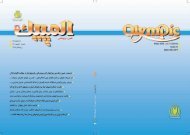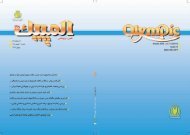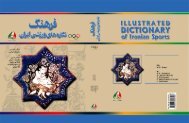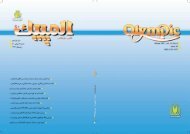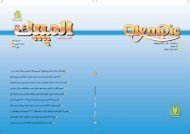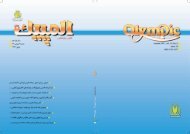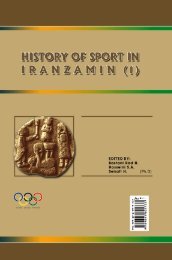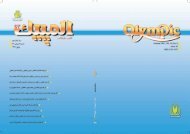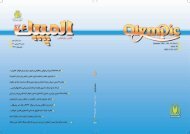In The Name Of Allah The Compassionate The Merciful
3 Main Supplement_Dr_Khabiri - آکادمی ملی المپیک و پارالمپیک
3 Main Supplement_Dr_Khabiri - آکادمی ملی المپیک و پارالمپیک
- No tags were found...
Create successful ePaper yourself
Turn your PDF publications into a flip-book with our unique Google optimized e-Paper software.
<strong>In</strong> <strong>The</strong> <strong>Name</strong> <strong>Of</strong> <strong>Allah</strong> <strong>The</strong><br />
<strong>Compassionate</strong> <strong>The</strong> <strong>Merciful</strong>
Kaveh Khabiri<br />
عضو بورد تخصصی<br />
B.S., Human Nutrition<br />
M.Sc., Physical Education<br />
Ph.D., Exercise Physiology<br />
NCDFS,, MPEA,,<br />
Cl. Vita<br />
کانادا<br />
سرپرست دپارتمان طب ورزشی PIRC<br />
مدرس دوره های مشترک دانشگاه متروپولیتن انگلستان<br />
رئیس کمیته کودکان و نوجوانان IFSAF<br />
عضو انجمن جهانی بهبود سبک زندگی (<br />
عضو بورد تخصصی آکادمی ملی المپیک<br />
)<br />
GALSI<br />
عضو کمیته تغذيه و بهداشت فدراسیون پزشكی ورزشی<br />
مدرس دوره های تخصصی بین المللی وزنه برداری و تكواندو غرب آسیا<br />
کارشناس برنامه ی علم و ورزش صدا و سیمای جمهوری اسالمی ايران
بخش اول
Protein<br />
Supplementation
<strong>In</strong>troduction<br />
اکثر مصرف کنندگان بر این باورند که مکمل ها نقش کلیدی و<br />
اصلی را در موفقیت ورزشکاران ، چه در تمرینات و چه در<br />
بازگشت به حال اولیه و چه در مسابقات ایفا می کنند.<br />
بسیاری از محققین و مراجع ذیصالح علمی نشان داده اند که<br />
در بسیاری از مکمل ها بین آنچه واقعا در ترکیبات آنها است و<br />
آنچه بر روی برچسب آنها ذکر شده است تفاوت وجود دارد.<br />
•<br />
•<br />
%25<br />
• چیزی در حدود 10<br />
تا<br />
از مکمل های پروتئینی چنین<br />
وضعیتی را دارند.
<strong>In</strong>troduction<br />
مواد اصلی که عموما آلودگی مكمل های پروتئینی با آنها صورت گرفنه<br />
است عبارتند از:<br />
• stimulants (i.e. ephedrine )<br />
• anabolic androgenic steroids<br />
(i.e. testosterone, nandrolone)<br />
• AAS precursors, so-called prohormones<br />
androstenedione, norandrostenedione)<br />
• all of which are on the World Anti Doping Agency’s<br />
(WADA) list of forbidden substances.<br />
(AAS)<br />
(i.e.<br />
• <strong>The</strong>se results are extremely important for those athletes<br />
who are subject to in- or out-of-competition antidoping<br />
controls.<br />
•
دیدگاه های مختلف در بررسی مکمل های پروتئینی<br />
•<br />
•<br />
از چند ديدگاه قابل بررسی است:<br />
طبقه بندی<br />
• Classification<br />
•<br />
مكمل های آلوده به مواد ممنوعه<br />
• Supplement contamination with doping substances<br />
تضمین کیفیت در تولید مكمل ها<br />
• Quality assurance in the production of supplements<br />
آيا مصرف مكمل موجب تمايل و گرايش به دوپینگ می شود؟<br />
• Does the use of supplements promote a doping<br />
attitude?
طبقه بندی 1<br />
• (powder, pill, capsule, drink),<br />
• internet, over the counter,<br />
شكل:<br />
میزان دسترسی<br />
• (provide energy, assist recovery, build muscle)<br />
عملكرد<br />
پشتوانه علمی<br />
تايید شده در تحقیقات مستند،<br />
تايید نشده در تحقیقات مستند،<br />
تحقیقات غیر مستند<br />
•<br />
•<br />
•<br />
•<br />
•<br />
•<br />
•
Protein<br />
• Proteins are essential to the structure and function of<br />
all living things.<br />
• Made of strings of amino acids linked with peptide<br />
bonds.<br />
• From just 21 amino acids, millions of different proteins<br />
may be created.<br />
• Amino acid basic structure:<br />
R-CH(NH 2 )-COOH
Amino Acids<br />
• Essential amino acids (8):<br />
• Isoleucine, leucine, lysine, methionine,<br />
phenylalanine, threonine, tryptophan, valine.<br />
• Non-essential amino acids (9):<br />
• Alanine,arginine, aspartic acid, glutamine, glutamic<br />
acid, hydroxyproline, ornithine, proline, serine.
Semi-essential<br />
amino acids
Semi-essential amino acids<br />
• Histidine (essential in children)<br />
• Glycine (essential in rapid growth)<br />
• Cysteine (essential if methionine is limited)<br />
• Tyrosine (essential if phenylalanine is limited)
Proteins in the body<br />
• Hormones (e.g. insulin, thyroxine)<br />
• All enzymes<br />
• Structural (e.g. collagen, keratin, fibrin)<br />
• Muscle protein (actin and myosin)
Protein turnover<br />
• Approximately 2 % of total body protein is<br />
broken down and re-synthesised each day.<br />
• As protein is broken down, some nitrogen is lost<br />
in the urine. <strong>The</strong> obligatory nitrogen loss in the<br />
urine reflects the minimum protein intake<br />
(adjusted for bioavailability) for a healthy adult.
Protein Quality<br />
Chemical analysis of the amino acids<br />
• Amount of each essential amino acid per 100 g of test<br />
protein compared with that of the same amino acid in<br />
100 g of hen’s egg protein.<br />
• <strong>The</strong> amino acid with the lowest value is termed the<br />
LIMITING AMINO ACID.<br />
• <strong>The</strong> AMINO ACID SCORE of a protein is the value<br />
of the limiting amino acid expressed as a percentage<br />
of the same amino acid in hen’s egg protein.
Protein Quality<br />
Biological Analysis<br />
• This is a measure of protein utilisation in<br />
growing children or rats.<br />
• Net Protein Utilisation (NPU) = (Nitrogen<br />
Retained in the Body/Nitrogen in the diet) x<br />
100
Examples of protein quality<br />
Amino Acid<br />
Score<br />
NPU (Children)<br />
Hen’s egg 100 87 94<br />
Human milk 100 94 87<br />
Cow’s milk 95 81 82<br />
Soya 74 67 65<br />
Rice 67 63 59<br />
Millet 63 43 44<br />
Wheat 53 49 48<br />
Maize 49 36 52<br />
NPU (Rats)
تا سقف<br />
110 گرم از برنامه غذایی<br />
•<br />
%60 به%40<br />
•<br />
• بقیه از مکمل<br />
اگر از مکمل ها استفاده شود نسبت<br />
%30 به%70<br />
•
طبقه بندی 2<br />
برخی از صاحب نظران علوم ورزشی سیستم زير را برای طبقه<br />
بندی مكمل ها پیشنهاد نمودند<br />
•<br />
• dietary supplements<br />
• nutritional ergogenic aids,
طبقه بندی<br />
و جایگاه مکمل های پروتئینی در آن<br />
Australian <strong>In</strong>stitute of Sport (AIS)<br />
(AIS)<br />
انستیتو ورزش استرالیا اقدام به طبقه بندی علمی برای مکمل ها نمود<br />
که بر حسب میزان موثر تا خطرناک بودن در گروه<br />
قرار داده است<br />
(A, B, C or D)<br />
4<br />
.<br />
در گروه A موادی قرار دارند که مستقیما یا غیر مستقیم موجب بهبود کارآیی<br />
می شوند.<br />
مکمل هایی که در اثر بخشی آنها شواهد و مدارکی ارائه می شود و یا اغلب<br />
بنظر می رسد که در کارآیی موثرند در گروه B هستند.<br />
performance<br />
C<br />
گروه آندسته از مکمل ها که تحقیقات ارگوژن بودن آنها را تایید نکرده<br />
است و یا به حد کافی تحقیقات مستند در مورد انها در دسترس نمی باشد<br />
گروه D<br />
موادی هستند که منع مصرف آنها توسط<br />
AIS<br />
شده است.<br />
•<br />
•<br />
•<br />
•<br />
•
Group A Supplements<br />
Supported for use by AIS athletes<br />
• antioxidants<br />
• bicarbonate<br />
• caffeine<br />
• calcium<br />
• creatine<br />
• electrolyte replacement<br />
• glucosamine<br />
• glycerol<br />
• iron<br />
• liquid meal supplements<br />
• multivitamin/mineral<br />
• sick pack<br />
• sports bars<br />
• sports drink<br />
• sports gels
Group B Supplements<br />
Considered for provision to AIS athletes only under a research protocol<br />
• colostrum<br />
• glutamine<br />
• HMB<br />
• melatonin<br />
• probiotics<br />
• ribose
• branched chain amino acids<br />
• (& other free-from amino acids)<br />
• Carnitine<br />
• chromium picolinate<br />
• coenzyme Q10<br />
• cytochrome C<br />
• gamma-oryzanol & ferulic acid<br />
• Ginseng<br />
• <strong>In</strong>osine<br />
• nitrous oxide supplements<br />
• oxygen boosters<br />
• Pyruvate<br />
• rhodiola rosea<br />
Group C Supplements<br />
• vitamin supplements when used in situations other than<br />
summarised in Group A
Group D Supplements<br />
• <strong>The</strong>se supplements should not be used<br />
• Androstenedione<br />
• 19-norandrostenediol<br />
• 19-norandrostenedione<br />
• DHEA<br />
• ephedra<br />
• strychnine<br />
• tribulus terrestris & other herbal<br />
• testosterone supplements
Building Blocks<br />
as<br />
Ergogenic Aids
•<br />
•<br />
•<br />
•<br />
•<br />
•<br />
•<br />
•<br />
•<br />
•<br />
•<br />
ریز مغذیها به عنوان عوامل کارساز<br />
اسیدهای آمینه<br />
آرژينین، اورنی تین ، سیترولین و فرآورده های آنها<br />
آسپارتات<br />
آسپاراژين<br />
اسیدهای آمینه شاخه دار<br />
والین ، لوسین و ايزولوسین<br />
گلوتامات<br />
گلوتامین<br />
گلیسین<br />
لیزين<br />
تريپتوفان
آرژینین، اورنی تین ، سیترولین و فرآورده های آنها 1<br />
اين سه اسید آمینه بنا به داليل زير حائز اهمیت هستند :<br />
سنتز پروتئین<br />
ترشح ، سوماتوتروپین ، انسولین و پروالکتین<br />
حمل آمونیاک خون<br />
سنتز کراتین<br />
سنتز پلی آمینها<br />
سنتز نیتريک اکسید<br />
•<br />
•<br />
•<br />
•<br />
•<br />
•<br />
•
آسپارتات 1<br />
اسپارتات فوائد متابولیكی زيادی دارد که عبارتند از :<br />
حمل مواد معدنی به سايتهای درون سلولی<br />
یکی از مواد مهم مرتبط با چرخه کربس و اگزالو استات که در<br />
تامین انرژی نقش فراوانی دارند<br />
بخشی از چرخه اوره<br />
.<br />
(<br />
عامل برداشت آمونیك<br />
.)<br />
بازسازی ATP<br />
يكی از عوامل ضد بروز فرايند خستگی<br />
کنندگی نوروترانسمیترها<br />
( مرکزی<br />
. )<br />
تحريک<br />
•<br />
•<br />
•<br />
•<br />
•<br />
•
آسپارتات 2<br />
برخی تحقیقات مصرف نمک آسپارتات را در تعويق خستگی ،<br />
طی ورزشهای استقامتی مؤثر می دانند و زمان تعويق خستگی را<br />
از تا درصد بیشتر عنوان کرده اند<br />
.<br />
1998<br />
Wesson<br />
(<br />
50 15<br />
.)2002Wolinsky<br />
•<br />
DL<br />
نمک از نوع ، نسبت به نوع<br />
خون مؤثرتر بوده است<br />
البته در موارد کمتر از<br />
L<br />
7<br />
De Hann<br />
بويژه در کاهش آمونیاک<br />
گرم تغییری گزارش نشده است<br />
.<br />
)<br />
1995<br />
،<br />
1993Hagen<br />
(<br />
•<br />
•
آسپاراژین<br />
در مغز و عضالت وجود دارد و در شرايط استراحت ،<br />
مستقیما در عضالت به گلوتامین تبديل می شود،.<br />
این اسید آمینه میزان مصرف اسیدهای چرب را افزایش می دهد<br />
عاملی برای حفظ و حمایت از گلیکوژن عضالنی است)<br />
Lancha<br />
)2005<br />
Graham ،<br />
2005<br />
غلظت زیاد آسپاراژین در عضالت ، باز سازی<br />
انقباضات شدید عضالنی محدود میکند<br />
ATP<br />
نقش مهم مصرف آن ، حمایت از تولید گلوتامین است<br />
را پس از<br />
Schmidbaur<br />
(<br />
. )<br />
1991<br />
Soderland<br />
،<br />
1990<br />
•<br />
•<br />
•<br />
•<br />
•
(<br />
:<br />
اسیدهای آمینه شاخه دار<br />
شامل والین ، لوسین و ایزولوسین است<br />
بنظر می رسد می توانند خستگی را در ورزشهای استقامتی ، از طریق کاهش<br />
مقدار تریپتوفان آزاد پالسما ، به تعویق اندازند ، زیرا افزایش مقدار تریپتوفان<br />
آزاد پالسما می تواند مقدار سروتونین مغز را افزایش داده و باعث بروز<br />
خستگی مرکزی شود و همکاران<br />
استفاده از مکمل اسیدهای آمینه شاخه دار به مقدار گرم در ساعت تا<br />
سقف گرم در روز بر بهبود عملکرد استقامتی موثر گزارش شده است<br />
(<br />
)<br />
5/0<br />
2004<br />
.<br />
)<br />
2006<br />
Davis<br />
Mittleman<br />
،<br />
21<br />
2003 Hefler<br />
مضافا تغییرات هورمونی در طول فعالیت ورزشی و پیشگیری از تخریب<br />
عضالت اسکلتی از دیگر اثرات ذکر شده در مصرف مکمل های این<br />
اسیدهای آمینه است<br />
Combes<br />
،<br />
2003<br />
Maclean ،<br />
2004<br />
De palo<br />
(<br />
. )<br />
2006<br />
در خصوص اثر مثبت مصرف این گروه از اسیدها آمینه در ورزشهای قدرتی<br />
هنوز اطالعات زیادی در دسترس نیست .<br />
•<br />
•<br />
•<br />
•<br />
•
“<br />
گلوتامین 1<br />
يكی از بیشترين اسیدهای آمینه موجود در پالسما و عضالت<br />
میباشد و بنظر می رسد دارای اثرات زير است<br />
جلوگیری از افزايش ناگهانی اسید الکتیک طی فعالیتهای بدنی<br />
افزايش سنتز پروتئین های عضالنی<br />
محدود کردن تجزيه و شكسته شدن پروتئین ها<br />
پیش ساز برخی از ناقلین شیمیايی عصبی<br />
پیشگیری از کاهش قدرت سیستم ايمنی ناشی از بیش تمرينی<br />
افزايش سوماتوتروپین<br />
افزايش سرعت ترمیم ذخاير گلیكوژن عضالت<br />
برداشت آمونیاک خون در طول فعالیت بدنی<br />
”<br />
:<br />
•<br />
•<br />
•<br />
•<br />
•<br />
•<br />
•<br />
•<br />
•
گلوتامین 2<br />
يكی از بیشترين اسیدهای آمینه موجود در پالسما و عضالت<br />
میباشد و بنظر می رسد دارای اثرات زير است<br />
فشار بیش از حد تمرينات بیش تمرينی و فعالیتهای شديد و<br />
کوتاه مدت میزان گلوتامین پالسما را کم میکند و بر توانايی<br />
سیستم ايمنی نیز اثر منفی دارد<br />
،<br />
2004<br />
:<br />
Bucci<br />
2002<br />
)<br />
Parry-billings (<br />
(<br />
. )<br />
2006<br />
Rowbotton<br />
مصرف گرم از اين ماده بعد از اجرای مسابقات ماراتون تاثیر<br />
کمی بر سیستم ايمنی داشته است<br />
1994<br />
Poortmans<br />
(<br />
. )<br />
1996<br />
10<br />
Mackinnon ،<br />
بیشترين تحقیقات انجام شده در مورد گلوتامین مربوط به<br />
مصرف آن در انواع روشهای جراحی ، تروما ، سوختگیها و<br />
جراحات است.<br />
•<br />
•<br />
•<br />
•
What is it?<br />
o<br />
Creatine<br />
Synthesized from AA in the Liver,<br />
Pancreas, and Kidneys<br />
o Skeletal muscles holds about 95% of the 120 g to 140<br />
g Creatine found in our bodies.<br />
o Short duration of Loading phase through 20 g/day (4<br />
Dose of 5g) for 5-7 days.<br />
o<br />
long duration of Loading phase through 3 g/day (in<br />
one does) for 30 days.<br />
59
Creatine<br />
‣ <strong>The</strong>n maintenance stage of 1.5 - 2 gm day<br />
o<br />
o<br />
Pills, Powders, Liquids,<br />
Chewing Gum, and Gels:<br />
Food Sources: (1 - 2 g / Kg)<br />
60
61<br />
Creatine
62<br />
Creatine
SUPPLEMENT<br />
New Approach
New classification of<br />
supplements
Preparation For Competition<br />
Immune Function<br />
( SUPC ) ( SUPC )<br />
Fat Loss<br />
Muscle Building<br />
General Health
Categories<br />
• General Health<br />
• Muscle Building<br />
• Fat Loss<br />
• Immune Function
General Health and Supplement Use<br />
in Preparation for Competition<br />
• Cycling Supplements<br />
• EFAs<br />
• Herbs<br />
• Joints<br />
• HPT,HPA,&HPG Axis<br />
• Mind Supplements
Muscle Building and Supplement<br />
Use in Preparation for Competition<br />
• Amino Acids<br />
• Creatine<br />
• Gainers<br />
• Glutamine<br />
• Protein
Fat Loss and Supplement Use in<br />
Preparation for Competition<br />
• Caffeine<br />
• Conjugated Linoleic Acid<br />
• Green Tea<br />
• L-Carnitine
Immune Function and Supplement<br />
Use in Preparation for Competition<br />
• Alpha Lipoic Acid<br />
• Antioxidants<br />
• Vitamins and Minerals
General Health
General Health and Supplement Use<br />
in Preparation for Competition<br />
• Cycling Supplements<br />
• EFAs<br />
• Herbs<br />
• Joints<br />
• HPT,HPA,&HPG Axis<br />
• Mind Supplements
Whey protein<br />
• carbohydrates are the key.<br />
• combination of hydrolyzed whey<br />
proteins and low glycemic<br />
carbohydrates act in synergy to<br />
increase nitrogen retention .<br />
• taking whey with a high GI carb<br />
is good for after a work out,<br />
• small meals should be actual<br />
meals with protein, fats, and low<br />
GI carbs.
• Avoid:<br />
• Saturated Fat<br />
• Trans Fats<br />
• Cholesterol<br />
• Balance:<br />
• Monounsaturated & Polyunsaturated Fat<br />
• Omega 3 Fatty Acids
Herbs I<br />
1. Alfalfa<br />
2. Artichoke Extract<br />
3. Ashwagandha<br />
4. Avena Sativa<br />
5. Banaba<br />
6. Barberry<br />
7. Bergenin<br />
8. Black Cohosh<br />
9. Boswellia<br />
1. Burdock<br />
2. Cayenne<br />
3. Chlorella<br />
4. Dandelion<br />
5. Dong Quai<br />
6. Echinacea<br />
7. Evodiamine<br />
8. Fenugreek<br />
9. Forskolin
Herbs II<br />
1. Fo-Ti<br />
2. Garlic<br />
3. Ginger Root<br />
4. Ginkgo Biloba<br />
5. Ginseng<br />
6. Goldenseal<br />
7. Gotu Kola<br />
8. Grape Seed<br />
9. Gymnema Sylvestre<br />
10. Hoodia Gordonii<br />
11. Jojoba<br />
1. Kava Kava<br />
2. Maca<br />
3. Momordica<br />
4. Olive Leaf<br />
5. Pygeum<br />
6. Rhodiola<br />
7. Smilax<br />
8. Spirulina<br />
9. Stevia<br />
10. Tribulus<br />
11. Yohimbe
Joints<br />
• Celadrin<br />
• Glucosamine<br />
• Chondroitin sulphate
Mind Supplements<br />
• Mind can directly affect physical performance.<br />
• <strong>The</strong>re are 2 main aspects of keeping a healthy<br />
mind.<br />
• physical care through healthy eating and nutrient<br />
supplementation.<br />
• <strong>The</strong> other part consists of non-physical aspects that<br />
have just as important a role in keeping a healthy<br />
mind and brain.
Mind Supplements<br />
• <strong>The</strong>re are numerous vitamins, minerals, trace<br />
minerals, phytonutrients, and other compounds<br />
that are important for the body, specifically<br />
brain health.<br />
• Left Brain Activities<br />
• Right Brain Activities
Left Brain Activities:<br />
• Crossword puzzles<br />
• Number puzzles<br />
• Logic problems or<br />
puzzles<br />
• Quizzes<br />
• Analyzing information<br />
Right Brain Activities:<br />
• Creative art<br />
• Writing<br />
• Poetry<br />
• Activities that require visually<br />
discerning colors, shapes,<br />
dimensions, and hidden objects.<br />
• Reading
What Are <strong>The</strong> Best Supplements For<br />
Mind Health?<br />
• Greens Powder Blends<br />
• Wheat grass powder<br />
• Spirulina<br />
• Chlorella<br />
•Essential Fatty Acids<br />
• <strong>The</strong> best sources of omega-3 acids are:<br />
• Fish (EPA/DHA)<br />
• Fish oil (EPA/DHA)<br />
• Flax seeds (ALA)<br />
• Flax oil (ALA)<br />
• Multi Vitamins<br />
• Minerals
Which Are Best For Memory?<br />
• Ginkgo Biloba<br />
• To make a tea, simply steep the leaves in the hot water, the same way you would with any other tea<br />
• Choline<br />
• <strong>The</strong> recommended daily intake for choline is approximately 550 mg for adolescent and adult males,<br />
and between 400 and 425 mg for women<br />
• Phosphatidyl choline only contains 13% choline.<br />
• Beef liver, or other liver - 355 mg per 3 oz serving<br />
• Wheat Germ - 172 mg per cup<br />
• Eggs - 155 mg each (varies with size)<br />
• Salmon - 56 mg per 3 oz serving<br />
• Folate<br />
• Vitamin B-12
Which Are Best For Stress<br />
Reduction?<br />
•Peppermint/Spearmint<br />
• Mints are a classic herb for reducing stress and<br />
relaxing the body.<br />
•Valerian<br />
• Valerian has effect on the nervous system. It is excellent for<br />
relaxation or as a sleep aid.<br />
• <strong>The</strong> root is the part that is used. An extract or a tea can be<br />
used. A tea is a far better choice than a commercial extract<br />
• A tea will have a strong, distinct flavor Honey or stevia<br />
sweetener can be added to mask the flavor.
What Are Some Everyday Tips For<br />
Keeping A Healthy Mind?<br />
• Clean Living<br />
• Experience <strong>The</strong> Outdoors/Nature<br />
• Laughter<br />
• Try Different Forms <strong>Of</strong> Exercise<br />
• Stay Hydrated<br />
• Eat Plenty <strong>Of</strong> Fruits & Vegetables<br />
• Eat All Colors<br />
• Use Nutritional Supplements
Muscle Building
Muscle Building and Supplement<br />
Use in Preparation for Competition<br />
• Amino Acids<br />
• Creatine<br />
• Gainers<br />
• Glutamine<br />
• Protein
Amino Acids
• weight gainers used to be fairly cheap protein powders loaded<br />
with sugar and fat to up the calorie content .<br />
• <strong>The</strong> quality of a protein is determined by how well your body<br />
can use it, (BV & BA )<br />
• Whey Protein Isolate - 159<br />
• Whey Protein Concentrate - 104<br />
• Whole Egg -???<br />
• Egg White -???<br />
• Chicken - 79<br />
• Casein - 77<br />
• Soy - 74
Popular Weight Gainers<br />
• Prolab's N Large 2<br />
• Twinlab's Super<br />
Gainer's Fuel 2500<br />
• Champion Nutrition<br />
Super Heavyweight<br />
Gainer<br />
• EAS Myoplex Mass<br />
• Weider Mega Mass<br />
4000
MRP
MRP 1<br />
• An MRP is also known as a meal replacement. An MRP is for<br />
exactly what it sounds; it is used to replace a meal.<br />
• Meal replacements are designed to give the proper amount of<br />
calories, amino acids, proteins, carbohydrate, etc; without most<br />
of the “bad” stuff we find in many quick meals. MRP’s are made<br />
to be very convenient and fast and are found in a variety of ways.<br />
• You can find meal replacement in:<br />
• Powders<br />
• Bar<br />
• Pre-Made Drink<br />
• Or Even Pastes
Fat Loss
• Caffeine is 99% orally bioavailable.<br />
• Levels tend to peak within 30-60 minutes.<br />
• passing through all biological membranes including the<br />
blood brain barrier.<br />
• <strong>The</strong> half-life is around 5 hours.<br />
• 80% of caffeine is metabolized to paraxanthine by<br />
CYP1A2.<br />
• Several direct pharmacological effects include<br />
• adenosine receptor antagonism,<br />
• release of intracellular calcium,<br />
• phosphodiesterase inhibition,<br />
• and GABA receptor antagonism.
adenosine<br />
G i<br />
AC<br />
Ca 2+<br />
NT<br />
Release<br />
A1<br />
RECEPTOR<br />
Other pathways<br />
ATP<br />
CELLULAR EFFECTS<br />
Energy metabolism<br />
Smooth muscle contraction,<br />
vasoconstriction<br />
NT Release (Ca 2+ channel flux)<br />
cAMP<br />
Protein<br />
Kinases
Caffeine<br />
G i<br />
AC<br />
Ca 2+<br />
NT<br />
Release<br />
A1<br />
RECEPTOR<br />
Other pathways<br />
ATP<br />
CELLULAR EFFECTS<br />
Energy metabolism<br />
Smooth muscle contraction,<br />
vasoconstriction<br />
NT Release (Ca 2+ channel flux)<br />
cAMP<br />
Protein<br />
Kinases
Caffeine's metabolites and their<br />
respective actions follow:<br />
• 1. <strong>The</strong>obromine:<br />
• <strong>The</strong>obromine serving as a vasodilator.<br />
• 2. <strong>The</strong>ophylline:<br />
• <strong>The</strong>ophylline relaxes the smooth muscles and<br />
increases heart rate efficiency.<br />
• 3. Paraxanthine:<br />
• Paraxanthine aids lipolysis.
Conjugated Linoleic Acid content of common foods<br />
FOOD<br />
Typical mgs of CLA per<br />
gram<br />
% of CLA present<br />
as c9, t11 isomer<br />
Lamb 5.6 92<br />
Homogenized<br />
cow's milk<br />
Homogenized<br />
cow's milk<br />
5.5 92<br />
4.8 84<br />
Butter 4.7 88<br />
Cottage cheese 4.5 83<br />
Fresh ground<br />
beef<br />
Sharp cheddar<br />
cheese<br />
4.3 85<br />
3.6 93<br />
Chicken 0.9 84
Green Tea 3<br />
• You can find green tea in several different ways.<br />
• You may find them in capsule or tablet form as a supplement, in<br />
tea form to be enjoyed as a drink, or even in leaf form to be used<br />
topically for sunburns or pain.<br />
• <strong>The</strong> recommended dose for the tablet or capsule form should be<br />
around 300-600mg daily before or with meals.<br />
• If you are going to enjoy green tea, as a tea, it is recommended that<br />
you use 1 teaspoon of tea leaves with 1cup of boiling water three<br />
times daily with or before meals.<br />
• Green Tea does contain caffeine and should be avoided directly<br />
before bedtime to prevent insomnia.
<strong>The</strong> Benefits <strong>Of</strong> Green Tea I<br />
• Tannins - A group of simple and complex<br />
phenol, polyphenol, and flavonoid<br />
compounds.<br />
• Green tea after a meal can aid in digestion
Other Benefits <strong>Of</strong> Green Tea I<br />
• Catechins - Catechins are a category of<br />
polyphenols.<br />
• <strong>In</strong> green tea, catechins are present in<br />
significant quantities, more specifically;<br />
• epicatechin (EC),<br />
• epigallocatechin (EGC),<br />
• epicatechin gallate (ECG)<br />
• and epigallocatechin gallate (EGCG).
Other Benefits <strong>Of</strong> Green Tea II<br />
• A cup of green tea may provide 10-40mg of<br />
polyphenols.<br />
• Green tea extracts rich in EGCG<br />
(epigallocatechin gallate) are thought to increase<br />
fat metabolism.<br />
• EGCG makes up about 10-50% of the total<br />
catechin content and appears to be the most<br />
powerful of the catechins - with antioxidant<br />
activity about 25-100 times more potent than<br />
vitamins C and E.
Other Benefits <strong>Of</strong> Green Tea III<br />
• Flavonoids - Flavonoids are plant pigments,<br />
and are found in most fresh fruits and<br />
vegetables.<br />
• <strong>The</strong>y may aid in protecting against infection.<br />
Deficiency can result in a tendency to bruise<br />
easily.
Other Benefits <strong>Of</strong> Green Tea IV<br />
• <strong>The</strong>anine - theanine is a unique amino acid<br />
found in the leaves sencha.<br />
• <strong>The</strong>anine is quite different from the polyphenol<br />
and catechin antioxidants for which green tea is<br />
typically consumed.
<strong>In</strong>teractions With Medications I<br />
• Adenosine (used for irregular heart rhythm):<br />
Green tea inhibits action of adenosine.<br />
• Green tea contains Vitamin K and can make<br />
coumadin (warfarin) ineffective or less effective.<br />
<strong>The</strong> use of green and aspirin together may<br />
increase your risk of bleeding.<br />
• Beta-lactam Antibiotics (examples include<br />
cephalosporins and penicillins):<br />
Green tea may increase the effectiveness of<br />
beta-lactam antibiotics by reducing bacterial<br />
resistance to treatment.<br />
• Benzodiazepines (used for anxiety;) , Green tea<br />
reduces the sedative effects of benzodiazepines.
<strong>In</strong>teractions With Medications II<br />
• Beta-blockers :Green tea can increase blood<br />
pressure in people taking beta blockers.<br />
• Clozapine Green tea can reduce the<br />
effectiveness of clozapine if green tea is taken<br />
less than 40 minutes before taking clozapine.<br />
• Ephedrine Green tea and ephedrine together<br />
will increase the incidence of agitation, tremors,<br />
insomnia, and weight loss.
<strong>In</strong>teractions With Medications III<br />
• Lithium (for treatment of mania and<br />
depression):<br />
Green tea can reduce blood levels of lithium (a<br />
medication used to treat manic/depression).<br />
• Monoamine oxidase inhibitors (MAOIs) (used<br />
for treating depression; examples include<br />
phenelzine and tranylcypromine):<br />
Green tea and MAOI's taken together may cause<br />
hypertensive crisis (severe increase in blood<br />
pressure).
References for Green Tea<br />
• Chantre P, Lairon D. Recent findings of green tea extract AR25 (exolise) and<br />
its activity for the treatment of obesity. Phytomedicine 2002:9:3-8.<br />
• Durlach PJ. <strong>The</strong> effects of a low dose caffeine on cognitive performance.<br />
Psychopharmacol 1998;140(1):116-9.<br />
• Imai K. Nakachi K. Cross-sectional study of effects of drinking green tea on<br />
cardiovascular and liver diseases. BMJ 1995;310:693-696.<br />
• <strong>In</strong>oue M, Tajima K, Mizutani M, et al. Regular consumption of green tea and<br />
the risk of breast cancer recurrence: follow-up study from the Hospital-based<br />
Epidemiologic Research Program at Aichi Cancer Center (HERPACC),<br />
Japan. Cancer Lett 2001;167:175-82.<br />
• Bushman JL. Green and cancer in human: a review of the literature. Nutr<br />
Cancer 1998;31(3):151-9.<br />
• Schulz V, Hansel R, Tyler VE. Rational Phytotherapy: A Physician's Guide to<br />
Herbal Medicine. Terry C. Telger, trans. 3 rd ed. Berlin , GER:Springer, 1998.<br />
• Ross GW, Abbott RD, Petrovitch H, et al. Association of coffee and caffeine<br />
intake with the risk of Parkinson disease. JAMA 2000;283:2674-9.
L-Carnitine I<br />
• Between two and four grams of L-carnitine should be<br />
taken one hour before exercise, for two weeks .<br />
• Some studies show positive results and others show no<br />
significant improvements. However, no adverse effects<br />
have been reported from L-carnitine use. This indicates<br />
that carnitine supplementation will produce either<br />
beneficial results or none at all .<br />
• Taking the right amount of carnitine is important to<br />
derive the benefits reported in scientific studies. For<br />
nutritional purposes or as part of a cardiovascularwellness<br />
program, 500 to 1,500 mg per day of L-<br />
carnitine should maintain tissue levels of carnitine.<br />
Lower levels of 100 to 500 mg may also be useful if<br />
taken on a regular basis.
Immune Function
Immune Function in preparation for<br />
• Antioxidants<br />
competition<br />
• Vitamins and Minerals<br />
• Alpha Lipoic Acid
11<br />
Antioxidants
Antioxidants<br />
• Exercise increased generation of free radicals<br />
• more antioxidants are commercially available especially from<br />
plant extracts<br />
• Virtually all researchs to date has focused on ascorbate,<br />
tocopherol, and selenium to the exclusion of thiols,<br />
bioflavinoids & carotenoids,<br />
12
Antioxidants in human tissues<br />
Endogenous production<br />
Bilirubin<br />
Catalase<br />
Coenzyme Q10 (Ubiquinone)<br />
Cysteine<br />
Glutathione<br />
Histidine<br />
Protein Sulfhydryl group<br />
Superoxide Dismutase<br />
Taurine<br />
Urate<br />
Dietary Source<br />
Anthocyanidins , Procyanidolic oligomers<br />
Vitamin C<br />
Beta –Carote & Carotenoids<br />
N-acetyle-L-cysteine<br />
Bioflavonoids<br />
Mannitol<br />
Methionine<br />
Plant Phenolic Acids<br />
Polyphenols (Tannins)<br />
Synthetic Antioxidants (BHA,BHT,TBHQ<br />
Zinc salts . Vitamin E<br />
13
General Antioxidants in Exercise<br />
Supplementation with Vitamin C:<br />
• Some of studies just reported doses (500-1000 mg/d) for<br />
more than 3 weeks found improved:<br />
• Efficacy of submaximal work loads,<br />
• peak work capacity,<br />
• muscular strength,<br />
• prevention of Exercise oxidation of blood glutathione,<br />
14
• Some of studies just reported doses (500-1000 mg/d) for<br />
more than 3 weeks found decrease in:<br />
<br />
• post exercise lactate<br />
• Heart rate<br />
<br />
General Antioxidants in Exercise<br />
Supplementation with Vitamin C:<br />
• Total energy cost of work<br />
• Oxygen debt<br />
• Oxygen consumption<br />
• Pulmonary ventilation<br />
• Blood glucose<br />
<br />
<br />
• Post-race upper respiratory tract infection<br />
15
General Antioxidants in Exercise<br />
• Supplementation with Vitamin E:<br />
• Some of studies just reported doses (400-1600 IU/d) for more<br />
than 3 weeks found decrease in:<br />
• Lower exercise blood lactate levels<br />
• Blood lipid peroxides<br />
• Leakage of muscle enzymes (including CPK)<br />
• Oxygen debt<br />
• Post exercise DNA damage<br />
• Especially in free radical production<br />
16
Alpha Lipoic Acid<br />
• Alpha Lipoic Acid (ALA) is an antioxidant used to:<br />
• Help prevent different diseases<br />
• Regulate blood sugar -which is important for the reduction of body fat<br />
• Fight free radicals<br />
• Delay muscle fatigue by helping to deliver energy into the muscles.<br />
• Main function of Alpha Lipoic Acid (ALA) is to increase the<br />
production of glutathione.<br />
• It is recommended that you should take 100 – 200 mg of Alpha<br />
Lipoic Acid (ALA) 2 – 3 times daily.<br />
• Alpha Lipoic Acid (ALA) may work better with vitamins such as<br />
Vitamin C, E, and glutathione.<br />
• For safety reasons, you should consult with your doctor before using.<br />
• <strong>In</strong> lactating or pregnancy periods, or if you have a thiamin deficiency<br />
Athletes should NOT use Alpha Lipoic Acid (ALA).
Supplement Combination
Supplement Combination<br />
• Colostrum ~ 60 g<br />
A<br />
• Creatine ~ 1.5 g<br />
• Carnitine ~ 1.5 g<br />
• Coenzyme Q10 ~ 75 mg
Supplement Combination<br />
• Creatine ~ 10-20g<br />
B<br />
• HMB ~ 3 g
Supplement Combination<br />
C<br />
• L-glycine ~ 0.12 mg/kg Body Weight<br />
• L-arginine ~ 0.47 mg/kg Body Weight<br />
• D/L-methionine ~ 2.33 mg/kg Body Weight<br />
• L-aspartate ~ 1.73 mg/kg Body Weight<br />
• L-Trp ~ 0.50 mg/kg Body Weight<br />
• L-Phe ~ 0.41 mg/kg Body Weight<br />
• L-His ~ 0.39 mg/kg Body Weight<br />
• L-Pro ~ 0.29 mg/kg Body Weight<br />
• D-ribose ~ 1.73 mg/kg Body Weight<br />
• Magnesium Phosphate ~ 1.49 mg/kg Body Weight
Supplement Combination<br />
• Phosphates (mix of sodium – potassium) 1g with<br />
every serving of Creatine<br />
D<br />
• Only short duration loading phase ( 6 days)
Supplement Combination<br />
• Whey Protein ~ 40 g<br />
E<br />
• Glutamine ~ 5 g<br />
• BCAA ~ 3 g
Supplement Combination<br />
• Zinc ~ 15 - 30mg<br />
F<br />
• Magnesium ~ 6 – 8 mg/Kg
Good Luck
Selected REFERENCES<br />
• Fredholm BB. Battig K. Holmen J. Nehlig A. Zvartau EE. Actions of caffeine in the brain<br />
with special reference to factors that contribute to its widespread use. Pharmacological<br />
Reviews. 51(1):83-133, 1999<br />
• MarNehlig A. Daval JL. Debry G. Caffeine and the central nervous system: mechanisms<br />
of action, biochemical, metabolic and psychostimulant effects. Brain Research - Brain<br />
Research Reviews. 17(2):139-70, 1992.<br />
• Christo G.; Jones S.L.; Haylett S.; Stephenson G.M.; Lefever R.M.H.; Lefever R.2003. <strong>The</strong><br />
Shorter PROMIS Questionnaire - Further validation of a tool for simultaneous<br />
assessment of multiple addictive behavioursAddictive Behaviors, March 2003, vol. 28, no.<br />
2, pp. 225-248(24)<br />
• Donovan JL. DeVane CL. A primer on caffeine pharmacology and its drug interactions in<br />
clinical psychopharmacology. Psychomacology Bulletin. 35(3):30-48, 2001<br />
• Durrant KL. Known and hidden sources of caffeine in drug, food, and natural products.<br />
Journal of the American Pharmaceutical Association. 42(4):625-37, 2002<br />
• Cifuentes F. Gonzalez CE. Fiordelisio T. Guerrero G. Lai FA. Hernandez-Cruz A. A<br />
ryanodine fluorescent derivative reveals the presence of high-affinity ryanodine binding<br />
sites in the Golgi complex of rat sympathetic neurons, with possible functional roles in<br />
intracellular Ca(2+) signaling.<br />
• Pisters KM. Newman RA. Coldman B. Shin DM. Khuri FR. Hong WK. Glisson BS. Lee<br />
JS. Phase I trial of oral green tea extract in adult patients with solid tumors. Journal of<br />
Clinical Oncology. 19(6):1830-8, 2001 Mar 15.<br />
• Zhang, Wei-Ya. A Benefit-Risk Assessment of Caffeine as an Analgesic Adjuvant. Drug<br />
Safety. 24(15):1127-1142, 2001.<br />
• Lieberman, Harris R. Ph.D.. <strong>The</strong> Effects of Ginseng, Ephedrine, and Caffeine on<br />
Cognitive Performance, Mood and Energy. Nutrition Reviews. 59(4):91-102, April 2001.
• Caffeine Dependence Syndrome: Evidence from Case Histories and Experimental<br />
Evaluations. Journal of Occupational & Environmental Medicine. 38(2):129-130, February<br />
1996.<br />
• Carrillo, Juan A.. Benitez, Julio. Clinically Significant Pharmacokinetic <strong>In</strong>teractions Between<br />
Dietary Caffeine and Medications. Clinical Pharmacokinetics. 39(2):127-153, August 2000.<br />
• Dager, Stephen R 1,2,3. Friedman, Seth D 2. Brain imaging and the effects of caffeine and<br />
nicotine. Annals of Medicine. 32(9):592-599, December 2000.<br />
• Zhang, W. Y. MD. Li Wan Po, A. BPharm PhD. Do codeine and caffeine enhance the<br />
analgesic effect of aspirin?-. April 1997.<br />
• Caffeine does not affect palpitations. Nursing Standard. 11(12):29, December 11, 1996.<br />
• Rush CR, Higgins ST, Hughes JR, Bickel WK, Wiegner MS. Acute behavioral and cardiac<br />
effects of alcohol and caffeine, alone and incombination, in humans.<br />
• Ascherio, A., Chen, H.. Schwarzschild, M.A.. Zhang, S.M.. Colditz, G.A. Speizer, F.E.<br />
Caffeine, postmenopausal estrogen, and risk of Parkinson's disease. Neurology. 60(5):790-<br />
795, March 11, 2003.<br />
• Warke, T J., Shields, Finnegan, J. Shields, Caffeine and exhaled nitric oxide. Thorax.<br />
58(3):281, March 2003.<br />
• Schwarzschild MA. Chen JF. Ascherio A. Caffeinated clues and the promise of adenosine<br />
A(2A) antagonists in PD. Neurology. 58(8):1154-60, 2002 Apr 23.<br />
• Astrup A, Toubro S, Christensen NJ, Quaade F. Pharmacology of thermogenic drugs. Am J<br />
Clin Nutr. 1992 Jan;55(1 Suppl):246S-248S.<br />
• Shum S. Seale C. Hathaway D. Chucovich V. Beard D. Acute caffeine ingestion fatalities:<br />
management issues.Veterinary & Human Toxicology. 39(4):228-30, 1997<br />
• Bruce MS. <strong>The</strong> anxiogenic effects of caffeine. Postgrad Med J. 1990;66 Suppl 2:S18-24.<br />
• Benowitz NL. Clinical pharmacology of caffeine. Annu Rev Med. 1990;41:277-88.
• Ottley C. Food and mood. Nursing Standard. 15(2):46-52; quiz 54-5, 2000<br />
• Courchesne, William E. Ozturk, Sedide. Amiodarone induces a caffeine-inhibited, MID1-<br />
depedent rise in free cytoplasmic calcium in Saccharomyces cerevisiae. Molecular<br />
Microbiology. 47(1):223-234, January 2003.<br />
• Diener, HC. Jansen, JP. Reches, A. Pascual, J. Pitei, D. Steiner, TJ. Efficacy, tolerability and<br />
safety of oral eletriptan and ergotamine plus caffeine (Cafergot) in the acute treatment of<br />
migraine: a multicentre, randomised, double-blind, placebo-controlled comparison..<br />
Headache. 43(3):301-301, March 2003.<br />
• McKenzie, Sacha. Marley, Philip D.. Caffeine stimulates Ca2+ entry through store-operated<br />
channels to activate tyrosine hydroxylase in bovine chromaffin cells. European Journal of<br />
Neuroscience. 15(9):1485-1492, May 2002.<br />
• Bouchard R. Weber AR. Geiger JD. <strong>In</strong>formed decision-making on sympathomimetic use in<br />
sport and health. Clinical Journal of Sport Medicine. 12(4):209-24, 2002<br />
• Kalow W, Tang BK. <strong>The</strong> use of caffeine for enzyme assays: a critical appraisal. Clin Pharmacol<br />
<strong>The</strong>r 1993; 53:503–514.<br />
• Graham TE, Rush JW, van Soeren MH. Caffeine and exercise: metabolism and performance.<br />
Can J Appl Physiol 1994; 19:111–138.<br />
• Le Marchand L, Franke AA, Custer L, et al. Lifestyle and nutritional correlates of cytochrome<br />
CYP1A2 activity: inverse associations with plasma lutein and alpha-tocopherol.<br />
Pharmacogenetics 1997; 7:11–19.<br />
• Grant DM, Tang BK, Kalow W. Variability in caffeine metabolism. Clin Pharmacol <strong>The</strong>r 1983;<br />
33:591–602.
• Dews PB. O'Brien CP. Bergman J. Caffeine: behavioral effects of withdrawal<br />
and related issues. Food & Chemical Toxicology. 40(9):1257-61, 2002<br />
• Smith A. Effects of caffeine on human behavior. Food & Chemical Toxicology.<br />
40(9):1243-55, 2002<br />
• Garrett BE. Griffiths RR. <strong>The</strong> role of dopamine in the behavioral effects of<br />
caffeine in animals and humans. Pharmacology, Biochemistry & Behavior.<br />
57(3):533-41, 1997 Jul.<br />
• Christian MS. Brent RL. Teratogen update: evaluation of the reproductive and<br />
developmental risks of caffeine. Teratology. 64(1):51-78, 2001<br />
• Nehlig A. Are we dependent upon coffee and caffeine? A review on human and<br />
animal data. Neuroscience & Biobehavioral Reviews. 23(4):563-76, 1999<br />
• Graham, Terry E.. Caffeine and Exercise: Metabolism, Endurance and<br />
Performance. Sports Medicine. 31(11):785-807, 2001.<br />
• Griffiths RR. Chausmer AL. Caffeine as a model drug of dependence: recent<br />
developments in understanding caffeine withdrawal, the caffeine dependence<br />
syndrome, and caffeine negative reinforcement. Nihon Shinkei Seishin<br />
Yakurigaku Zasshi. 20(5):223-31, 2000<br />
• Nurminen ML. Niittynen L. Korpela R. Vapaatalo H. Coffee, caffeine and<br />
blood pressure: a critical review. European Journal of Clinical Nutrition.<br />
53(11):831-9, 1999<br />
• Daly JW. Fredholm BB. Caffeine--an atypical drug of dependence. Drug &<br />
Alcohol Dependence. 51(1-2):199-206, 1998<br />
• Fredholm BB. Astra Award Lecture. Adenosine, adenosine receptors and the<br />
actions of caffeine. Pharmacology & Toxicology. 76(2):93-101, 1995 Feb.<br />
• Sawynok J. Pharmacological rationale for the clinical use of caffeine. Drugs.<br />
49(1):37-50, 1995 Jan.
Additional References<br />
‣ Sports Nutrition: “A guide for the professional working<br />
with active people. 3 rd Edition. ADA and Christine A.<br />
Rosenbloom PhD, Rd, Editor. 2000.<br />
‣ ACSM Health and Fitness Journals<br />
‣ Eat Smart, Play Hard. Liz Applegate, PhD. 2001.<br />
‣ <strong>The</strong> Health Professional’s Guide to Popular Dietary<br />
Supplements. Allison Sarubin, MS, RD. 2000.<br />
‣ Jacqueline R. Berning, PhD, RD. Assistant Professor,<br />
University of Colorado, Nutrition Consultant<br />
‣ Robert Murray, PhD, FACSM, Director, <strong>The</strong> Gatorade<br />
Sports Science <strong>In</strong>stitute.



